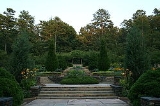
Sarah P. Duke Gardens
Encyclopedia
The Sarah P. Duke Gardens consist of approximately 55 acres (223,000 m²) of landscaped and wooded areas at Duke University
. There are five miles (8 km) of allées, walks, and pathways throughout the gardens. The gardens are divided into four areas, the Historic Core and Terraces, the H.L Blomquist Garden of Native Plants, the William Louis Culberson Asiatic Arboretum and the Doris Duke Center Gardens (including the Page-Rollins White Garden). The gardens are a memorial to Sarah P. Duke, wife of Benjamin N. Duke
, one of Duke University's benefactors.
, persuaded Sarah P. Duke to give $20,000 to finance the planting of flowers in the debris-filled ravine. By 1935, over 100 flower beds consisting of 40,000 iris
es, 25,000 daffodils, 10,000 small bulb
s and assorted annuals
graced the lawns. Unfortunately, the heavy rains of that summer and the flooding stream completely washed away the original gardens. By the time Sarah. P. Duke died in 1936, the gardens were completely destroyed. Dr. Hanes was able to convince Sarah P.Duke's daughter, Mary Duke Biddle
, to finance a new garden on higher ground as a memorial to her mother. Ellen Biddle Shipman
, a pioneer in American landscape design, was chosen to create the new garden, known as the Terraces, in the Italianate style. They are considered by many to be her greatest work.
goes directly through the Duke Gardens; there is a plaque designating a spot through which the meridian
runs.
Duke University
Duke University is a private research university located in Durham, North Carolina, United States. Founded by Methodists and Quakers in the present day town of Trinity in 1838, the school moved to Durham in 1892. In 1924, tobacco industrialist James B...
. There are five miles (8 km) of allées, walks, and pathways throughout the gardens. The gardens are divided into four areas, the Historic Core and Terraces, the H.L Blomquist Garden of Native Plants, the William Louis Culberson Asiatic Arboretum and the Doris Duke Center Gardens (including the Page-Rollins White Garden). The gardens are a memorial to Sarah P. Duke, wife of Benjamin N. Duke
Benjamin Newton Duke
Benjamin Newton Duke was a U.S. tobacco, textile, energy industrialist and philanthropist.-Biography:...
, one of Duke University's benefactors.
History
In the early 1920s, Duke University's planners intended to turn the area where the Sarah P. Duke Gardens are currently located into a lake. Funds for this project ran short and the idea was subsequently abandoned. The gardens then officially began in 1934, when Dr. Frederick Moir Hanes, a faculty member at the Duke Medical SchoolDuke University School of Medicine
The Duke University School of Medicine is Duke University's medical school operating under the auspices of the Duke University Medical Center. Established in 1925 by James B...
, persuaded Sarah P. Duke to give $20,000 to finance the planting of flowers in the debris-filled ravine. By 1935, over 100 flower beds consisting of 40,000 iris
Iris (plant)
Iris is a genus of 260-300species of flowering plants with showy flowers. It takes its name from the Greek word for a rainbow, referring to the wide variety of flower colors found among the many species...
es, 25,000 daffodils, 10,000 small bulb
Bulb
A bulb is a short stem with fleshy leaves or leaf bases. The leaves often function as food storage organs during dormancy.A bulb's leaf bases, known as scales, generally do not support leaves, but contain food reserves to enable the plant to survive adverse conditions. At the center of the bulb is...
s and assorted annuals
Annual plant
An annual plant is a plant that usually germinates, flowers, and dies in a year or season. True annuals will only live longer than a year if they are prevented from setting seed...
graced the lawns. Unfortunately, the heavy rains of that summer and the flooding stream completely washed away the original gardens. By the time Sarah. P. Duke died in 1936, the gardens were completely destroyed. Dr. Hanes was able to convince Sarah P.Duke's daughter, Mary Duke Biddle
Mary Duke Biddle
Mary Lillian Duke Biddle , was an American philanthropist.-Biography:She was born on November 16, 1887 in Durham, North Carolina as Mary Lillian Duke to Benjamin Newton Duke. She attended Durham's Trinity College, the institutional predecessor of Duke University, which was named in honor of her...
, to finance a new garden on higher ground as a memorial to her mother. Ellen Biddle Shipman
Ellen Biddle Shipman
Ellen Biddle Shipman was an American landscape architect known for her formal gardens and lush planting style.Born in Philadelphia, she spent her childhood in Texas and the Arizona territory. Her father, Colonel James Biddle, was a career Army officer, stationed on the western frontier...
, a pioneer in American landscape design, was chosen to create the new garden, known as the Terraces, in the Italianate style. They are considered by many to be her greatest work.
Trivia
The 36th line of latitudeLatitude
In geography, the latitude of a location on the Earth is the angular distance of that location south or north of the Equator. The latitude is an angle, and is usually measured in degrees . The equator has a latitude of 0°, the North pole has a latitude of 90° north , and the South pole has a...
goes directly through the Duke Gardens; there is a plaque designating a spot through which the meridian
Meridian (geography)
A meridian is an imaginary line on the Earth's surface from the North Pole to the South Pole that connects all locations along it with a given longitude. The position of a point along the meridian is given by its latitude. Each meridian is perpendicular to all circles of latitude...
runs.

